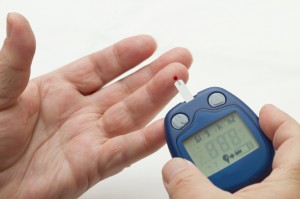No need to fear DIABETES
THE BEST STRATEGIES FOR PREVENTION AND THERAPY
S U G A R

Never before have we consumed as much sugar as we do now. Which is part of the reason why diabetes mellitus is becoming more and more of a problem. Even children are suffering from an acquired insulin deficiency, type 2 diabetes – often as a result of dietary errors.
Endurance sports and a healthy diet are the best actions to protect yourself from getting diabetes.

Measuring your blood sugar levels regularly is important in order to keep a dangerous increase or decrease (hypoglycemia) under control.

More and more people are developing type 2 diabetes, the so-called adult-onset diabetes. In comparison to type 1, it affects the majority of all people suffering from diabetes, that is, 90 % in Canada and 85 % in the U.S. And there is a high number of unrecorded cases. Therefore, education is more important than ever. Because the more you know about this
disease, the less it will scare you.
Type 2 diabetes is a disease that develops primarily as a result of dietary errors, excess weight and lack of exercise. As opposed to type 1 which is congenital, it is
possible to prevent its onset. The connection between a person’s lifestyle and this metabolic disorder has become so obvious that some even refer to diabetes as a lifestyle disease.
While in the past these relationships were simply not discussed, the first and primary goal should be prevention. Because the most commonly occurring form of
diabetes – type 2 diabetes – is avoidable, and can be healed in many cases. This type of diabetes used to be called adult-onset diabetes. But medical professionals
no longer like this term. Because in the meantime, approx. 90 percent of all diabetes cases are type 2, with more and more young people being affected, including children.
What differentiates type 2 from type 1?
In speaking of diabetes, you need to differentiate between the two types. They are actually two completely different diseases. Both of them have to do with insulin. But in the one case (type 1) the body no longer makes insulin. In the other (type 2), the body does still make it but the cells can no longer absorb the insulin because the receptors are either missing or
have stopped working over time. In simple terms, in type 2 diabetes it is the lock that no longer works, not letting the insulin in, while in diabetes type 1, it is already the key that’s missing.
In type 1 diabetes, insulin is no longer produced. While there is a genetic predisposition in most cases, the trigger often is a severe viral infection. It can disturb the immune
system to the point that it even destroys the cells responsible for the production of insulin.
Insulin is made by the so-called Langerhans’ cells in the pancreas. The body needs it in order to transport the sugar, which we get from food, to those parts of the body that need it. Be it the muscle cells or fat cells, but mostly the brain, which has the highest consumption of sugar of all of the organs.
In type 1 diabetes, the missing insulin needs to be supplied from external sources. Via a needle or so-called pen that has an injection needle at its tip. Insulin pumps have also become available recently. They are worn on the body, delivering insulin regularly via a catheter. The amount can be adjusted. Depending on the blood sugar measurement, you can feed the body
with more or less insulin.
Whether you use the pump or not – over time, most diabetics get used to measuring their blood sugar levels regularly and injecting themselves with the right amount of insulin.
Type 2 diabetes on the other hand, develops in a completely different way. Here, more and more insulin is produced initially, but the target cells no longer absorb it. Medical practitioners call it insulin resistance. Eventually, the body stops making insulin as a result of the continuous overload. It really is quite mean that this type of diabetes can
develop over a longer period without any warnings.
While substituting insulin is the basis of every type of therapy in type 1 diabetes, in type 2 it is the diet. Complemented by regular exercise. Additional treatment with drugs is generally the last resort – used only when the basic therapy is unsuccessful. It can include insulin or so called blood sugar lowering anti-diabetic drugs.
The best prophylaxis really is exercise, especially for those who are overweight. They may be at risk of their metabolic insulin going erratic. A diet rich in sugars and fats in combination with a lack of exercise inevitably leads to many metabolic diseases, and type 2 diabetes is one of them.
Engaging in High-performance Sports in spite of Diabetes
Nowadays people suffering from type 1 diabetes can lead a nearly normal life thanks to insulin. This includes top athletes such as football stars or the German
Olympic medallist in Heavyweight, Matthias Steiner.
It is physically possible for type 1 diabetics to actively engage in sports. And to prevent the once almost inevitable secondary diseases such as the prominent open leg sores and other dysfunctions of the blood vessels right up to amputations, loss of vision or dialysis. These nasty sequelae are more frequent than generally assumed, but they are avoidable by
taking the appropriate preventative measures. And by doing so, your quality of life will get better.

Winning the battle against diabetes
A fact barely known: Smoking can encourage the onset of diabetes too. It increases the risk of contracting the disease by about 60 %. I generally trust the body’s own self-regulating capabilities. What you need to do to get well is measure, eat and run. This is the most effective way to overcome your lifestyle diabetes!
For example, half an hour of jogging each day or alternatively another kind of endurance sport will help your body come to life. This type of consistent exercise can be of considerable help while you are on the road to recovery, but even more important is a change in the diet. Your primary concern here should not be losing excess weight. But by measuring your
blood sugar levels regularly, you will find out which foods and drinks keep your blood sugar at a stable level and which ones cause it to surge. You will find that a bottle of coke, which has about 20 sugar cubes in it, will increase levels substantially. So it is helpful to stay away from colas, lemonades and similarly sweetened drinks. Water and green tea, or a glass of dry wine once in a while is a much better choice.
I am not really a fan of diets of any kind. The yo-yo effect is just too big. Our body still reacts much in the same way as it did in the Stone Age. If it gets only minimal amounts of food, it will adjust. And then when there is more to eat, it will happily help itself and is eager to store everything. Because the bad times could be back.
Classical Homeopathy
In homeopathy, diabetes is seen as a reflection of the body’s inability to function optimally. There is an imbalance that results in the body’s incapacity to effectively utilize the
insulin that it produces, or to produce sufficient insulin for its needs. At K-W Homeopathic Medicine and Wellness Clinic, we specialize in Classical Homeopathy, which is a form of medicine that treats at the deepest possible level – the level of the vital force. While symptoms often disappear after conventional treatment, the vital force does not. It will find another outlet. We believe that healing cannot truly happen if the vital force is not healed.
The metabolic condition of a patient suffering from diabetes requires both therapeutic and nutritional measures to correct the illness. Along with the patient’s strict compliance to
a proper diet, homeopathy can regulate sugar metabolism while helping to resolve the metabolic disturbances that lead to diabetes. Furthermore, homeopathy helps stimulate the body’s self-healing powers in order to prevent complications such as open leg sores and other dysfunctions of the blood vessels rightup to amputations, loss of vision, kidney failure, hardening
of the liver, depression, and others.
A well-chosen homeopathic constitutional remedy that considers the person holistically, that is, not only the physical symptoms, but their mental and emotional states as well, will be
very beneficial to any diabetic, because it is the most individualized medicine you can get. Just think, out of more than 4,000 different remedies there will only be a handful or two that will be suited to the individual. This is precisely the reason why we have good results in homeopathic treatment. A remedy that resonates well with a person’s energy has the power to effectively support the body in its efforts to heal itself. Master homeopath George Vithoulkas, Director of the Athenian School of Homeopathic Medicine in Athens, Greece,
states that “Homeopathy has been of tremendous value in reversing diseases such as diabetes…”
Please feel free to call the clinic to book an appointment or to come in for a free 15 minute information session. We would be happy to answer your questions. (519) 603-0505.
Natural Treatment
There are a number of vitamins, minerals and supplements have proven to be very effective in controlling diabetes. The most well-known and probably most popular of these is
chromium. It is found in brewer’s yeast, meats and whole grains. Clinical studies in diabetics have shown that supplementing the diet with chromium can decrease total cholesterol and
triglyceride levels while increasing HDL-cholesterol levels, and lower body weight while increasing lead body mass. GTF (glucose tolerant factor) chromium proves to be the best form of chromium for diabetics because it promotes insulin sensitivity.
According to the Journal of Clinical Biochemistry and Nutrition, the plant Gymnema sylvestre is regarded as having potent anti-diabetic properties. This plant is also used for controlling obesity in the form of Gymnema tea. The active compound of the plant is a group of acids termed as gymnemic acids. It has been observed that there could be a possible link between obesity, Gymnemic acids and diabetes.
Certain vitamins, minerals and natural nutrients also play an important role in controlling and preventing diabetes:
Magnesium- for enzyme systems and pH balance. A deficiency in magnesium is very common among diabetics. Magnesium may help to prevent complications
from diabetes such as retinopathy and heart disease.
Vitamin B6 – because the vitamin B6 levels in the body cells appear to be linked to the magnesium content of the cell. That is, without vitamin B6,
magnesium will not get inside the cell and will therefore be useless.
Manganese- helps repair the pancreas and is a co-factor in key enzymes of glucose metabolism. Diabetics have been shown to have only one-half the
manganese of healthy individuals.
Vitamin C- helps maintain vascular health and strengthens the immune system. Fructose does not cause as significant a spike in blood sugar as glucose does. Since the absorption of vitamin C is facilitated by insulin, many diabetics are deficient of this crucial vitamin.
Vitamin E – helps improve circulation and insulin action and helps prevent the long-term complications of the disease. It is also an antioxidant.
Zinc and Vanadium- have insulin-like action. Zinc deficiency has been associated with diabetes.
Omega-3- diabetics are generally deficient in essential fatty acids or have an imbalance. Omega-3 has been shown to lower triglycerides.
Vitamin B12- is necessary in the prevention of diabetic neuropathy.
Coenzyme Q10- there is conflicting research about the effectiveness of coenzyme Q-10 for diabetes. Some research shows that taking coenzyme Q-10
might lower blood sugar levels, while other research has found no benefit. However, according to PubMed, Coenzyme Q 10 supplementation improves the function of inner lining of the conduit arteries of the peripheral circulation in dyslipidaemic patients with Type II diabetes.
Digestive Enzymes- especially helpful when the pancreas is not functioning optimally
Forget about diabetic food
Before you buy that special diabetic food, be sure to research the product, because all too often the labelling “specially formulated for diabetics” is misleading. Diabetic foods often contain the same amounts of sugar – only in the form of fructose, and also, they are often very high in fat. If you are not used to checking the ingredients carefully you could run into
problems because you might think that it is okay to eat as much of this product as you want to. Far from it! This kind of deception can lead to excess weight and an increased blood sugar levels too.
The only right thing to do is to watch carefully what you are eating, what is in the foods. You basically have to become an expert on ingredients and carefully watch your
body’s reaction and how it affects your blood sugar levels in order to know what is and isn’t good for you.
Enjoy eating – but eat right!
The best general advice I can give you is simply to enjoy your food, treat yourself to the best qualities and make sure that your menu includes all colours of the rainbow. If you can afford high quality organic foods and prepare your own meals, then that would already be very helpful.
Do not eat too much all at once – that is, not one huge portion, but rather several portions over the day. This can be helpful. Have plenty of dietary fiber, and protein – mostly of a vegetable source, such as tofu, legumes and grains – they all contain protein. It is best to avoid all sweets, in other words, no sweet snacks in between and no desserts.
The relatively richest meal of the day is best taken at lunch time. The body is able to tolerate it best at this time of day. Starting the day with a home- made muesli is perfect, because it has everything you need for good start. For example pre-soaked spelt grains, oatmeal, ground almonds, apple, freshly germinated fenugreek, yeast flakes, cocoa and soured milk.
Diabetics should not be tempted by so-called diabetic food. They contain just as much sugar as conventional food and often have more fat. The better option is to enjoy food in smaller quantities.

If you are diabetic, then making sure that your diet consists of high quality foods is particularly important.
Only the best types of Oils will do
Off limits is everything that contains a lot of fat. So fries and chips, sausage and bacon, cakes and cookies and fast food of any kind. This of course also includes fatty meats and everything containing hidden fats.
High quality oils on the other hand, such as olive oil and those containing the healthy omega-3 fatty acids are beneficial. For example flaxseed oil, hemp and walnut oil, canola and soy oil. The healthy omega-3 fatty acids are also included in fatty fish, such as salmon, anchovies, sardines, herring, mackerel and tuna
Canola oil is particularly rich in omega-3 fatty acids that are so healthy for diabetics.

Pasta – Diabetics should only have the Italian kind
You may find big differences in the way your body processes carbohydrates, particularly when it comes to pasta. Egg noodles are something you might want to avoid. But traditional Italian pasta made from durum wheat semolina seems to be used differently by the body and can therefore be recommended. Your blood sugar levels are unlikely to rise much after eating Italian pasta.

Diabetics should choose pasta made from durum wheat semolina. It does not cause blood sugar levels to rise as much as do regular types of pasta.
Run yourself to good Health!
It is very important to run, that is, to run healthily. If your style of running is such that you give it your all, going to the limit and exhausting yourself , then this will be of little help! Because only if there is enough air left when running, when there is oxygen there, it will get the metabolism going and have a regulating effect on blood sugar levels. The basic
rule is: Run only so fast that you could still have a conversation while running. Run with a smile on your face. Or use a pulse watch in the beginning to make
sure that you don’t exceed your limit. This is a good way to become aware of your training improvements. When you are able to run a little faster at the same pulse rate.
Of course, you need to get used to the running. To start with, you need to overcome your weaker self. But you can start slowly. And add a minute of running each day. In this way, you are outsmarting yourself over time. But you do need a clear resolve to do so. And discipline in carrying through.
How often and how long should you run for? Half an hour each day would be best. At least three hours per week. So you could run for an hour once in a while if you were not able to run the day before. It’s best to do it in a forested area or in a park where you can breathe in good air and where the ground is softer. Just asphalt does not do your feet any good. In this case, good shock absorbing shoes can be helpful, but of course only to a certain extent if the joint problems are already there.
Endurance Sports lower Blood Sugar levels
Soccer, squash, tennis and similar stop-and-go types of sports will do little to regulate blood sugar levels. Cycling is better, also Nordic walking, cross-county and hiking. Because additional sugar and fat can only be burned when there is regular and continuous stress on the body. This allows the production of insulin to level out again. It is also interesting to
know that the active burning off continues on after your run, when you are sitting at your desk or on the sofa.
Diabetics should engage in a type of sport they enjoy. The only important thing is persistence!

In order to avoid hypoglycemia, diabetics should always carry along some biscuits, fruit juice or grape sugar when engaging in sports.

Conclusion
While diabetes is a very serious disease, the treatment doesn’t have to be. Lifestyle modifications, weight loss and exercise, along with homeopathic
remedies, the right vitamins and supplements can make a tremendous difference. But it is very important to monitor your glucose levels carefully, either through
glucose monitoring tests or your physician, because natural approaches can alter the need for both insulin and insulin-control drugs. It is a good idea to find a practitioner who is supportive of alternative treatments and can further advise on the necessary lifestyle changes.
The goal of any doctor or patient should be to bring high blood sugar under control and stabilize it at a normal level. This can best be achieved by a treatment approach that incorporates bothm natural and conventional therapies, and also encourages diabetics to become actively responsible for their own health. An individually chosen constitutional homeopathic remedy is an excellent approach as it considers the person in a holistic way, incorporating symptoms at the physical, emotional and mental levels – because how you feel and how you think will ultimately affect you at the physical level. Often, your constitutional remedy will help you to make healthy decisions. I would be happy to answer your questions.
If you have any comments regarding this article or are interested in coming in for a free 15 minute information session on homeopathy, please call the clinic at (519) 603-0505.
Irene Schwens, C. Tran., DHMHS
Owner and Homeopath









